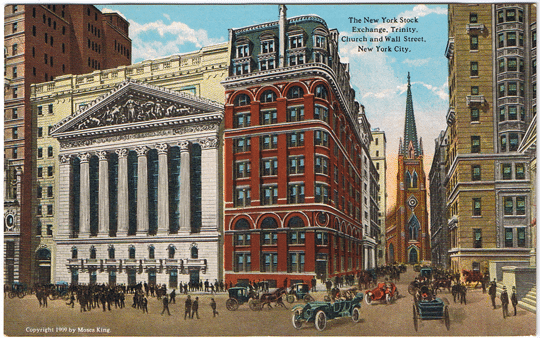
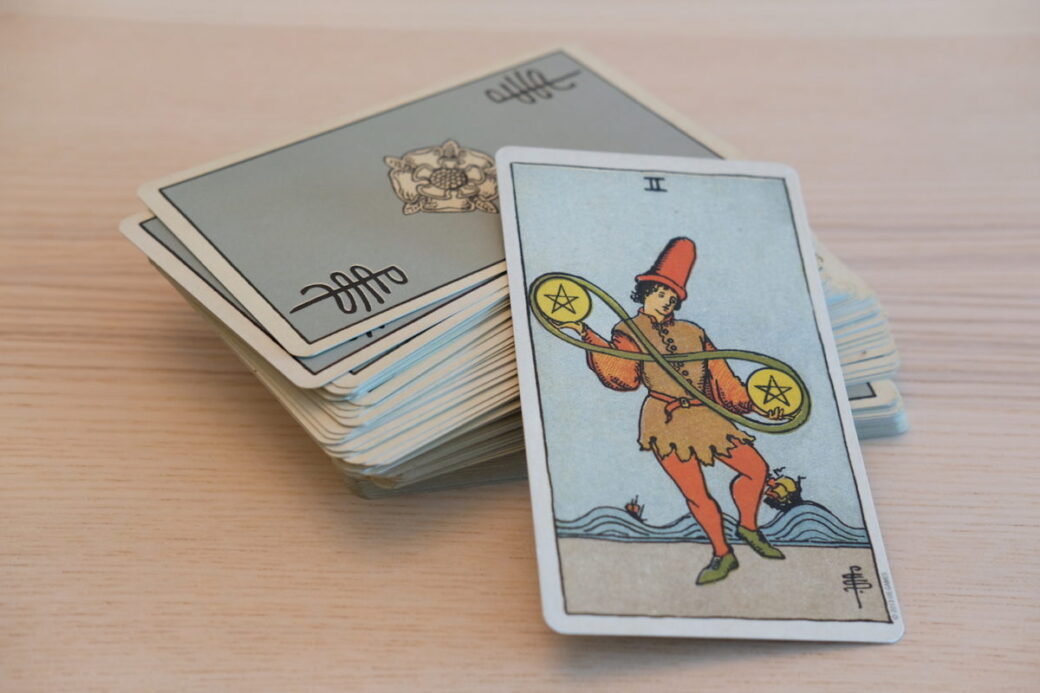

Two of Pentacles in the Tarot
The Two of Coins or Two of Pentacles, is a really good example of how Pamela Colman Smith took a standard Tarot image and reinterpreted it, according to her own experience. When you draw this card in a reading, from her deck – created with Arthur Waite – often called the Smith-Waite Deck – you are seeing money through her eyes. Pamela was a freelance artist, author and storyteller who juggled money.
Mary K. Greer, who must have the best Tarot research website in the world, cites Pamela’s well-known letter to her artistic mentor Alfred Stieglitz, back in 1909 when she was completing her commission to produce 78 cards for Arthur Waite and the Rider publishing company.
We find in a letter to her mentor, the pure cry of the Two of Coins – “I just finished a big job for very little cash!”
Arthur Waite, who was manager of the Horlick’s Food Company from 1900 t0 1909 and also editor of its journal, managed to place his own poetry and short occult pieces, as we find today in old copies of Horlick’s Magazine and Home Journal for Australia, India and the Colonies.
This is another classic Two of Coins issue. How do you pay the bills, but also earn the rewards of work you love? Waite could not make a full-time living from Tarot, nor any other aspect of the Occult, including astrology, in 1909.
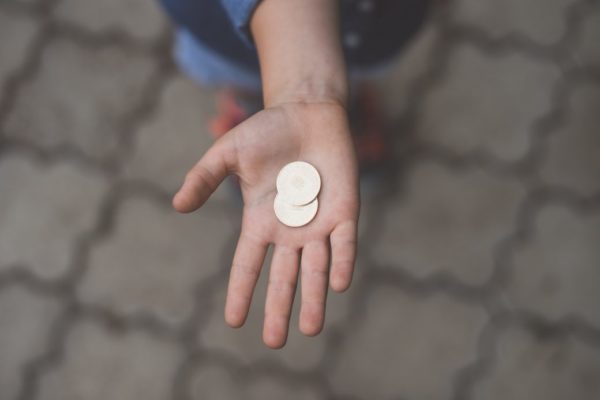
Understanding an Unbalanced Budget in the Tarot
An unbalanced budget is shown here, with credit on one side, and debt on the other. Money coming in and going out. Money 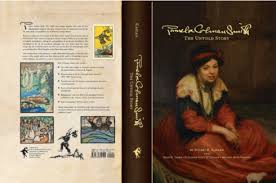 saved and being spent. This figure-eight loop is a clear picture of a situation which goes on forever (the figure-eight is the infinity symbol, often drawn by Pamela). In other words, money always goes in and out, like the tide. It was like this before you were born and it will be like this after you pass. Pamela herself, passed away with no money left after debts were settled. Ironically, her famous deck of Tarot cards, created with Arthur Waite, went on to make other people money after she passed. Pamela (pictured, captured in the wonderful new book Pamela Colman Smith – The Untold Story) was a woman in a man’s world in 1909, when she created the cards. She was a true Bohemian who worked on the cards, as she said in a well-known letter, for very little money. Pamela projected her own experience into the Two of Coins card, which shows someone juggling, trying to balance, ungrounded, off-centre while the two coins loop the loop – perhaps it is an infinite loop – of debts/credits.
saved and being spent. This figure-eight loop is a clear picture of a situation which goes on forever (the figure-eight is the infinity symbol, often drawn by Pamela). In other words, money always goes in and out, like the tide. It was like this before you were born and it will be like this after you pass. Pamela herself, passed away with no money left after debts were settled. Ironically, her famous deck of Tarot cards, created with Arthur Waite, went on to make other people money after she passed. Pamela (pictured, captured in the wonderful new book Pamela Colman Smith – The Untold Story) was a woman in a man’s world in 1909, when she created the cards. She was a true Bohemian who worked on the cards, as she said in a well-known letter, for very little money. Pamela projected her own experience into the Two of Coins card, which shows someone juggling, trying to balance, ungrounded, off-centre while the two coins loop the loop – perhaps it is an infinite loop – of debts/credits.
The importance of the ship in the background cannot be overestimated. In Pamela’s day, a good deal of trade relied on shipping, so the vessels you see being tossed around on the waves are a symbol of the national or international business picture. The national economy and the world economy. Today, of course, it relies on the internet more than shipping. This beautiful illustration was created by Pamela (below) for another project and shows a recurring motif in her work – the ebb and flow of uncertain tides. Seeing life through her eyes helps you understand the Two of Coins better.
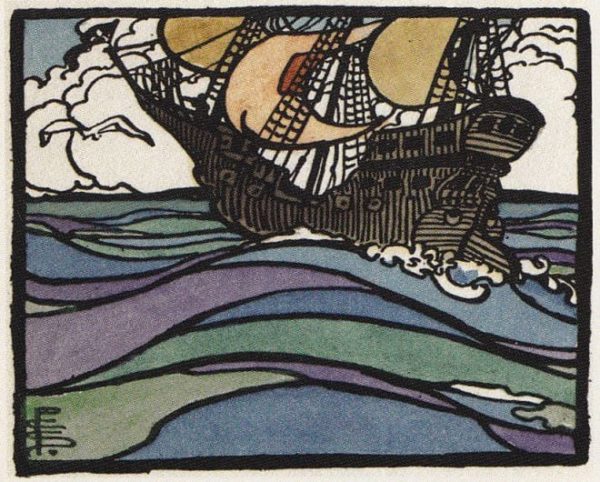
Working the Cards – Using the Before Tarot and After Tarot
As you may know from my workshops on the Tarot, I believe that Pamela was channelling the ‘new’ scientific knowledge about quantum mechanics when she created her deck. The thought had never occurred to me, until I went for a walk in Dublin and saw how closely W. B. Yeats (Pamela’s friend and fellow Tarot enthusiast) had lived next to Erwin Schrodinger. On the other side of Merrion Square, lived Oscar Wilde, whose wife Constance had also mixed in the same magical circle as Pamela and William Yeats. Thus, one of the fathers of quantum mechanics – the new proof of an uncertain reality – was a stone’s throw away from some of the most famous members of The Golden Dawn.
I’m sure you’ve heard about the Before Tarot and After Tarot decks. Published by Lo Scarabeo, with artwork by Eon and Simona Rossi and Giulia E. Massaglia, they show Pamela’s cards reimagined, as if the action was yet to begin – and later, as if the action was being completed. They give you a fantastic window into the creative possibilities of the Two of Coins. What happened before the money started being juggled? What might happen if the juggler (yourself) takes control and the ship comes in to shore? What other possibilities can you see?

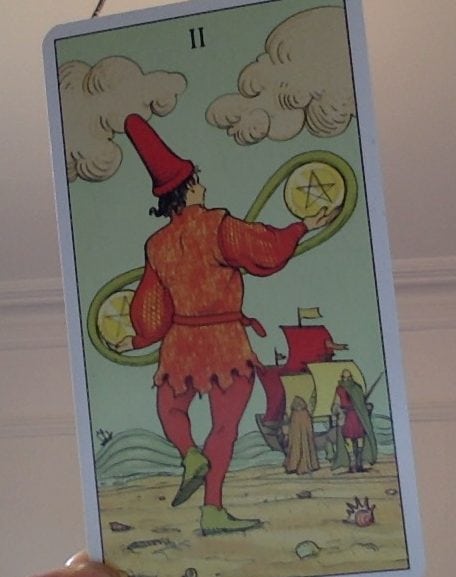
The Two of Coins and Financial Flexibility
The Two of Coins card is most likely to turn up when you are also having transits through Taurus (cash flow) and Scorpio (business, banking) in your personal birth chart. So, for example, you may find you have unpredictable Uranus passing through Taurus and your Second House of money, or perhaps he is opposing your Scorpio factors in the Eighth House.
Financial flexibility is the key to this card. You can’t hope for stability, unless the ships come to shore and stay there (but how will they trade?) The sea will always be wild and stormy unless we can control the elements! What this card tells you is that there some things you can master and some things you have to allow. What you can most certainly master is your own capacity to balance your budget. Perhaps, like Arthur Waite (below, Wikimedia Commons) you need to find a way to pay the bills but balance it with your need for work that doesn’t pay so well. In Waite’s time, this was the Tarot. It would take several decades and its rediscovery by Stuart R. Kaplan from U.S. Games Systems, before it paid its way.
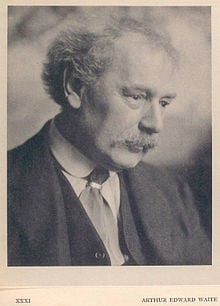
It all comes back to the wobbly, unstable, uncertain man in the card. This is you (or it may be someone else, if that was your question). So much to juggle! So much to try to add up! How can one calculate the priceless rewards of work that is loved, against the cost of working in a field that may be more about practical necessity than cash? We don’t know how Waite (pictured) felt about running Horlicks, but he must have loved putting the occasional piece on hypnosis into its house magazine for the colonies.
The trick with the Two of Coins is to centre, focus and concentrate. Who or what matters most to you? Can you put a price on peace of mind, stability, integrity? How about pricing soul satisfaction against the weekly pay cheque? This postcard (below, from Wikimedia Commons) shows the New York Stock Exchange in 1909, the year Pamela created her Two of Coins card. You can see all the business of trade, in the shape of the financiers to the left of the building. The Wall Street Crash was 20 years away but Pamela may have clairvoyantly seen aspects of it, when she dreamed up this unusual image of a man frantically juggling two golden coins while a larger and smaller ship are tossed around in the background. What is the Two of Coins saying to you and how can you work with the image to change it, to your satisfaction? Pamela’s illustrations often hid coded imagery – for you to interpret.
